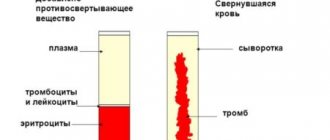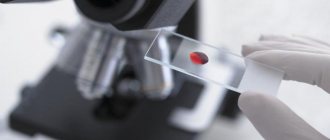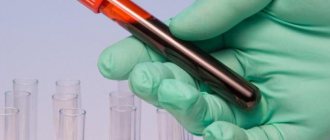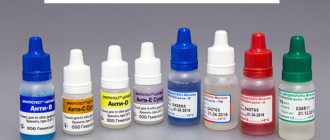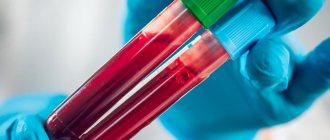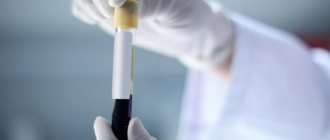When is it prescribed?
This type of laboratory test is prescribed to confirm the diagnosis and again to monitor the effectiveness of treatment. The results of a biochemical blood test show:
- the condition of the organs that take part in the formation and processing of blood cells (bone marrow, spleen, lymph nodes, liver);
- activity of hormonal and circulatory systems;
- deficiency of vitamins and microelements vital for the body;
- the functioning of the excretory system;
- physiological aspects of all types of metabolism.
Preparing for analysis
In order for the analysis indicators to correspond to reality, simple preparation for the procedure is necessary.
- Blood is donated for biochemical blood testing on an empty stomach in the morning. If it is not possible to donate blood early in the morning, then blood can be collected at any other time, but you should not eat 6 hours before the procedure.
- For a few days it is necessary to eliminate alcohol, fatty and sweet foods.
- You must refrain from smoking 2 hours before the test.
- The day before the procedure, avoid heavy physical activity.
- Before taking blood, you need to sit for 15-20 minutes in a calm state, if the person has experienced a strain on the heart (walked at a fast pace, climbed the stairs).
How is blood serum obtained?
Blood serum can be obtained in several ways:
— In a thermostat, where sterilely drawn blood is placed for half an hour. After this, using a pipette, the clot is peeled off from the wall of the test tube and placed in the refrigerator. The remaining serum is drained or aspirated into a sterile tube.
— By neutralizing fibrinogen elements with calcium ions, thereby dramatically increasing stability.
— By natural coagulation, the so-called native serum is obtained.
Biochemical blood test (normal table)
When assessing the results of a study, it is customary to use reference values - indicators of the norm of a biochemical blood test in adults, which are approximately the same for healthy people. In some cases, normal levels may differ between men and women.
| Name, measure | Abbreviation | Norm for women | Norm for men |
| Total protein, g/liter | Tp | 60-85 | 60-85 |
| Albumin, g/l | Albu | 35-50 | 35-50 |
| Fibrinogen, g/l | 2-4 | 2-4 | |
| Total bilirubin, µmol/l | Tbil | 8,5-20,5 | 8,5-20,5 |
| Indirect bilirubin, µmol/l | Dbil | 1-8 | 1-8 |
| Direct bilirubin, µmol/l | Idbil | 1-20 | 1-20 |
| Aspartate aminotransferase, units/l | Alt (AST) | < 31 | < 41 |
| Alanine aminotransferase, units/l | Ast (ALT) | < 35 | < 45 |
| (Gamma)-glutamine transferase, units/l | Ggt (GGT) | < 40 | < 55 |
| Alkaline phosphatase, units/l | Alp (ALP) | 30-110 | 30-110 |
| Triglycerides, mol/l | Trig | 0,4-1,8 | 0,4-1,8 |
| Cholesterol, mol/l | Chol | 3,5-5,5 | 3,5-5,5 |
| VP lipoproteins, mol/l | Hdl (HDL) | 1,7-3,5 | 1,7-3,5 |
| Fibrinogen, g/l | Fg | until 6 | 2-4 |
| Amylase, units/l | Amyl | 20-125 | 20-125 |
| Uric acid, µmol/l | Uric asid | 150-350 | 210-420 |
| Creatinine, µmol/l | Crea | 55-95 | 62-120 |
| Urea, µmol/l | Urea | 2,8-7,2 | 2,8-7,2 |
| C-reactive protein, mg/l | Crp (CRP) | < 0,5 | < 0,5 |
| Antistreptolysin O, units/l | Also | < 200 | < 200 |
| Glucose, µmol/l | Glu | 3,8-6,3 | 3,8-6,3 |
| Potassium, mmol/liter | Ka | 3,35-5,35 | 3,35-5,35 |
| Sodium, mmol/liter | Na | 130-155 | 130-155 |
| Calcium, mmol/liter | 2,15-2,5 | 2,15-2,5 | |
| Magnesium, mmol/liter | 0,65-1 | 0,65-1 |
Interpretation of biochemical blood test in adults
Protein in the blood
Total blood protein is the general name for all types of protein (about 160 types) in plasma. All types of proteins are divided into 3 fractions:
- Albumins occupy the largest part of the total blood protein and are necessary as a material for the construction of new cells.
- Globulins are proteins from which, if necessary, proteins of the immune system are synthesized - antibodies, etc.
- Fibrinogens are responsible for blood clotting. The number of fibrinogens is the smallest of all fractions of total protein.
The amount of total protein in the analysis results is an indicator of the functioning of the liver, heart, and immune system. Total protein is also responsible for the following blood functions:
- maintaining acid-base balance;
- work of the vascular system and heart;
- clotting;
- transport of hormones;
- immune reactions.
An increase in total protein in biochemical analysis indicates a variety of diseases associated with:
- integrity of the skin and tissues (traumas, burns, postoperative conditions);
- allergic reactions;
- systemic diseases (lupus erythematosus, diabetes insipidus, rheumatism);
- liver diseases (liver cirrhosis, hepatitis).
The value of total protein increases after extensive bleeding, a long period of vomiting and diarrhea.
A decrease in protein levels is observed after surgery, bleeding, burns, and poisoning. Total protein increases in diseases of the liver, gastrointestinal tract (enterocolitis, pancreatitis), kidney problems (nephritis) and anemia.
Albumin
Albumin is a low molecular weight protein that performs construction and transport functions.
Exceeding the norm of albumin is observed in case of poisoning (vomiting, diarrhea, dehydration), viral infections, arthritis, diabetes, nephritis.
A decrease in albumin levels can be caused by diseases of the gastrointestinal tract, kidneys, heart, liver, as well as fasting.
The amount of albumin in blood biochemistry is influenced by medications: corticosteroids can cause an increase in levels, and some hormonal drugs (estrogens) significantly reduce the level of albumin and globulin.
Blood determination
Serum for blood group recognition must be standard, that is, a certain group prepared from human blood. For the test, you need to prepare a dry glass slide, standard serum of the three blood groups, sodium chloride solution, cotton wool, glass rods and pipettes.
The slide is divided into three sectors, into which a drop of serum from each blood group is placed using different pipettes. Using a glass rod, drops of the collected blood are transferred to a plate next to the serum. Using new sticks, alternately mix the blood with the serum until a uniform pink color is obtained. After three minutes, add saline solution to each mixture obtained. Constantly shaking the slide we monitor the reaction. Already in the first minutes of a positive reaction, grains, which are glued red blood cells, should be visible. These grains can merge into larger ones, and sometimes a positive reaction can appear in the form of flakes of different sizes. In case of a negative reaction, the original pink color of the mixture will remain unchanged.
Blood serum is not just a complex mixture that can tell about the state of the body, but also an important element of most antiviral drugs.
Fats (lipids)
The lipid profile of a biochemical blood test includes all compounds with fatty acids:
- cholesterol (or total cholesterol);
- triglycerides;
- lipoproteins of different densities.
Cholesterol
Cholesterol is the main element of the plasma fat spectrum, which is secreted by the liver and enters the body from food of animal origin. Cholesterol levels increase with age, especially in women.
There are several types of cholesterol:
- Alpha lipoprotein
is the “good” cholesterol. In the results, it is designated by the abbreviation HDL - high-density lipoproteins, which help rid the heart and blood vessels of fatty deposits. - Beta lipoprotein
is “bad” cholesterol of two types: LDL (low-density lipoprotein) and VLDL (very low-density lipoprotein). This type of cholesterol transports fat molecules to internal organs and contributes to the development of diseases of the cardiovascular system.
Increased cholesterol is called hyperlipidemia, and is caused by hereditary problems with fat metabolism. In addition, the amount of cholesterol in plasma increases in certain diseases: coronary heart disease, diabetes mellitus, atherosclerosis, renal failure, hypothyroidism.
A critical decrease in cholesterol in a biochemical blood test signals problems with the gastrointestinal tract (poor intestinal absorption), lack of nutrition, and is also a symptom of liver cirrhosis.
Triglycerides
Triglycerides are lipid organic compounds called neutral fats. Triglycerides are used as an energy resource: cell nutrition depends on the normal amount of fatty acids.
An increase in triglycerides indicates a violation of fat metabolism, renal and liver failure, which is typical for diabetes mellitus, hypothyroidism, obesity, cardiac ischemia, and also when taking hormonal drugs.
A decrease in triglyceride levels in tests may indicate starvation of the body, hyperthyroidism, kidney problems, or an excess of vitamin C.
What is blood serum?
This is a yellowish liquid separated from the blood clot. Its specific color indicates the presence of bile pigment - bilirubin. It is used for biochemical analyses, research for the presence of various types of infectious diseases, and for assessing the effectiveness of vaccination. Serum from a person or animal immunized with a specific antigen can become an immune serum used to diagnose and treat a number of diseases. It is also used to determine blood type. For clinical practices, fresh or previously frozen blood serum is used.
Glucose
Glucose (sugar) in the blood is a complex of simple carbohydrates that enter the blood from food and are processed by the liver. Glucose is a source of energy for all cells in the body.
Hypoglycemia
- a condition in which the body lacks glucose. Glucose deficiency is caused by various physiological and pathological reasons.
Physiological causes of hypoglycemia:
- hunger;
- thirst;
- intense physical activity;
- stress;
- eating large amounts of simple carbohydrates.
Pathological causes of hypoglycemia:
- diabetes;
- exhaustion;
- renal failure;
- gastrointestinal disorders;
- liver failure;
- cirrhosis;
- problems with the hormonal system.
Hyperglycemia
- a condition that occurs against the background of a disorder of the pancreas, with high glucose levels.
There are three forms of hyperglycemia based on the results of blood biochemistry for glucose:
- mild (glucose level 6-10);
- average (10-16);
- heavy (above 16).
In addition to pancreatic insufficiency, temporary physiological hyperglycemia may occur due to stress and overeating of simple carbohydrates.
Plasma electrolytes
Electrolytes are blood elements that are formed during the breakdown of salts, alkalis and acids, having a positive or negative charge (cations and anions). The main plasma electrolytes include potassium, sodium, magnesium, and calcium.
Electrolytes play an important role in the metabolic processes of cell nutrition, the formation of bone and muscle cells, the functioning of the neuromuscular system, the removal of excess water from the intercellular space, and also in maintaining blood acidity.
| Electrolytes | Reasons for the increase | Reasons for the downgrade |
| Sodium (affects the functioning of the nervous and muscular systems, takes part in the functioning of other electrolytes) | Dehydration, abuse of salty foods, adrenal hormonal disorders, kidney failure (sodium is not excreted) | Lack of salt in food, vomiting, diarrhea, sweating, hyperthyroidism, cardiac, liver, adrenal failure |
| Potassium (responsible for water balance in the body and the absence of edema) | Injuries, burns, kidney and adrenal failure, acidification of the body, shock | Fasting, excess coffee and tea, refined sugar, kidney disease, long-term intestinal disorders |
| Calcium (regulates heart rhythm, impulse transmission in the nervous system, participates in muscle contraction and blood clotting processes, is responsible for strong bones and teeth) | Parathyroid overfunction, hyperthyroidism, kidney problems, malignant bone tumors, bone tuberculosis | Hypothyroidism, renal, liver failure, pancreatic diseases |
| Magnesium (required for normal functioning of the heart and nervous system, participates in the metabolic processes of other blood electrolytes) | Hypothyroidism, kidney and adrenal diseases | Fasting, lack of food, digestive disorders with diarrhea and vomiting, gastrointestinal diseases, hyperthyroidism, parathyroid insufficiency, rickets, excess calcium |
| Iron (plays a major role in oxygen metabolism of cells) | Liver diseases, chemical poisoning, lack of B vitamins and folic acid, taking hormonal drugs | Prolonged bleeding, tumors, hypothyroidism, anemia, lack of vitamins B 12, B 6 |
| Chlorine (participates in the oxygen exchange of the alveoli of the lungs, is part of the gastric juice) | Excessive secretion of hormones by the adrenal cortex, dehydration, diabetes insipidus, excessive alkalization of the body | Vomiting, diarrhea, excessive fluid intake, kidney failure, diuretic abuse, head injury |
Nitrogen exchange
During the life of the body, there is a need to remove the products of cell breakdown (nitrogen metabolism) - urea, uric acid and creatinine, which are removed from the plasma with the help of the liver.
Urea is the result of the breakdown of ammonia. An increase in the permissible amount of urea in the results of a biochemical blood test indicates excessive consumption of protein products and kidney disease. Too low urea levels occur during pregnancy, liver cirrhosis and low protein diet.
Uric acid
- This is a product of the digestive process, produced by the liver and required by the body in minimal doses.
Excess uric acid occurs with liver and kidney diseases, alcoholism, various types of anemia, and gout. A low amount of uric acid (to the lower limit of normal) can be caused by hypothyroidism, liver failure, and frequent urination.
Creatinine
is a substance that is the result of metabolic processes in muscle tissue. Creatinine is excreted from the body by the kidneys.
If an increased level of creatinine is present in the interpretation of the analysis values, this indicates excess protein nutrition, extreme physical activity, impaired renal function, and hormonal imbalances (in thyrotoxicosis).
High creatinine is observed when using creatine-based drugs for muscle growth. It is typical that the result for creatinine is high both during intensive muscle growth and during muscle breakdown.
Why is biochemistry needed?
Biochemistry helps to detect diseases of the circulatory system, internal organs, and establish the level of glucose, bilirubin and urea. These indicators can only be determined from the results of a biochemical study. It is carried out in the clinic laboratory or using a portable analyzer. This study is indicated to draw up a clinical picture of pathologies occurring in the body. It helps determine:
- Glucose level, since a decrease or increase in its levels may indicate improper functioning of the pancreas due to the development of diseases that impair its functions (diabetes mellitus, oncology, etc.),
- The level of bilirubin, a substance remaining after the breakdown of red blood cells. Its deficiency or excess indicates pathologies of the liver or gall bladder (hepatitis, acute cholecystitis and others),
- Hemoglobin level, an increase or decrease in which is a sign of poor coagulation, anemia, leukemia, HIV infection, etc.
- The level of urea, which characterizes the function of the kidneys and liver, and any deviations from the norm indicate the malfunction of these organs,
- The level of protein, the increase of which in the body threatens obesity and the development of rheumatoid arthritis, and the decrease - problems with the heart and coronary vessels, which is confirmed by a cardiogram.
Biochemistry is often prescribed to those who have undergone chemotherapy or have problems with the circulatory system, heart pathologies and vascular diseases.
Typically, a doctor prescribes a test during an examination and doubts about the diagnosis, so it is not recommended to undergo it yourself. Biochemical analysis and general analysis differ significantly, so they are prescribed based on the patient’s health condition and the expected diagnosis.

